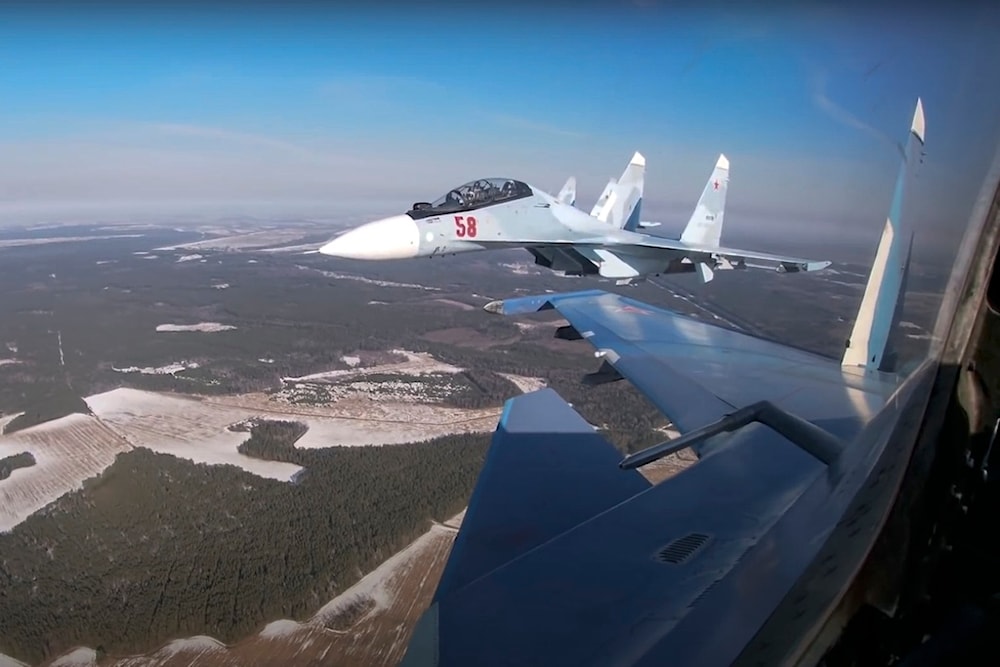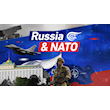NATO monitors joint Russian-Belarusian military exercises
NATO's long-range radar detection aircraft closely monitored joint Russian-Belarusian military exercises from the skies over Poland and the Baltic states, with Belarus implementing countermeasures to reduce NATO's intelligence effectiveness.
-

Screengrab by the Russian Defense Ministry Press Service on February 17, 2022, Su-30 fighters of both air forces fly in a joint mission during the Union Courage-2022 Russia-Belarus drills in Belarus. (AP)
NATO's aircraft closely monitored the joint exercises of the Russian and Belarusian militaries from the skies over Poland and the Baltic states, Leonid Davidovich, deputy commander of the Belarusian Air Force and Air Defense Forces and chief of Aviation said.
"During the active phase of [our] exercise, several long-range radar detection aircraft hovered over Poland and the Baltic states. We realized that they were monitoring all our flights and tracking our activities," Davidovich explained.
According to the Deputy Commander, Belarus has "long ago learned to respond to them" and is "countering them in a certain way, taking measures to reduce the effectiveness of their intelligence."
Davidovich pointed out that during the joint Belarusian-Russian air exercises on May 27-31, most of the Belarusian Air Force aviation was involved.
"That is, all air bases and all types of aircraft took part in the exercises in one way or another," he said adding that "the maximum number of servicemen participated, and the maximum range of tasks was performed. During the exercise, the sides exchanged experience, with Russian pilots sharing more with our pilots," Davidovich noted.
On May 27-31, Moscow and Minsk held joint flight and tactical exercises involving the Belarusian Air Force and Air Defense Troops, along with the Russian Aerospace Forces.
This comes amid growing tensions between the alliance and Russia with several members of the EU and NATO announcing they have greenlit Ukraine to use western weapons against targets inside of Russia.
Biden 'understands consequences' of allowing strikes in Russia: Kirby
US President Joe Biden is fully aware of the potential consequences of his decision to partially lift the ban on strikes by Ukrainian armed forces inside Russian territory with US-supplied weapons, White House National Security Communications Advisor John Kirby stated on Sunday.
"The president looked at that, talked to the interagency team, made sure he understood all the ramifications of the request, and then approved it. It is limited to the Kharkiv region. And it is limited with respect to the kinds of targets they can hit and how far back they can go," Kirby told ABC News.
This follows a recent decision from the United States to lift restrictions on Ukraine's use of US-supplied weapons against targets in Russian territory, though officials claim that Biden made the move "only to defend the under-fire" Kharkiv region against Russian forces.
The State Department clarified that the US has not authorized the use of long-range missiles, including ATACMS, inside Russia.
French President Emmanuel Macron has also been a strong advocate of this initiative.
On Friday, German Federal Government spokesperson Steffen Hebestreit mentioned that Berlin, along with other Western nations, agreed that Kiev could use Western weapons to repel attacks in the Kharkiv region.
President Vladimir Putin warned NATO allies earlier this week that they should realize "what they are playing with" when they allow Ukraine to use long-range Western weapons to strike deep into Russia.
"These representatives of NATO countries, especially in Europe, especially in small countries, they should be aware of what they are playing with. They should remember that this is usually a state with a small territory and a very dense population. This is a factor they should keep in mind before striking deep into Russian territory," Putin said during a press conference on May 28.
Read more: Putin warns NATO: Consider the cost before strikes on Russia

 4 Min Read
4 Min Read









